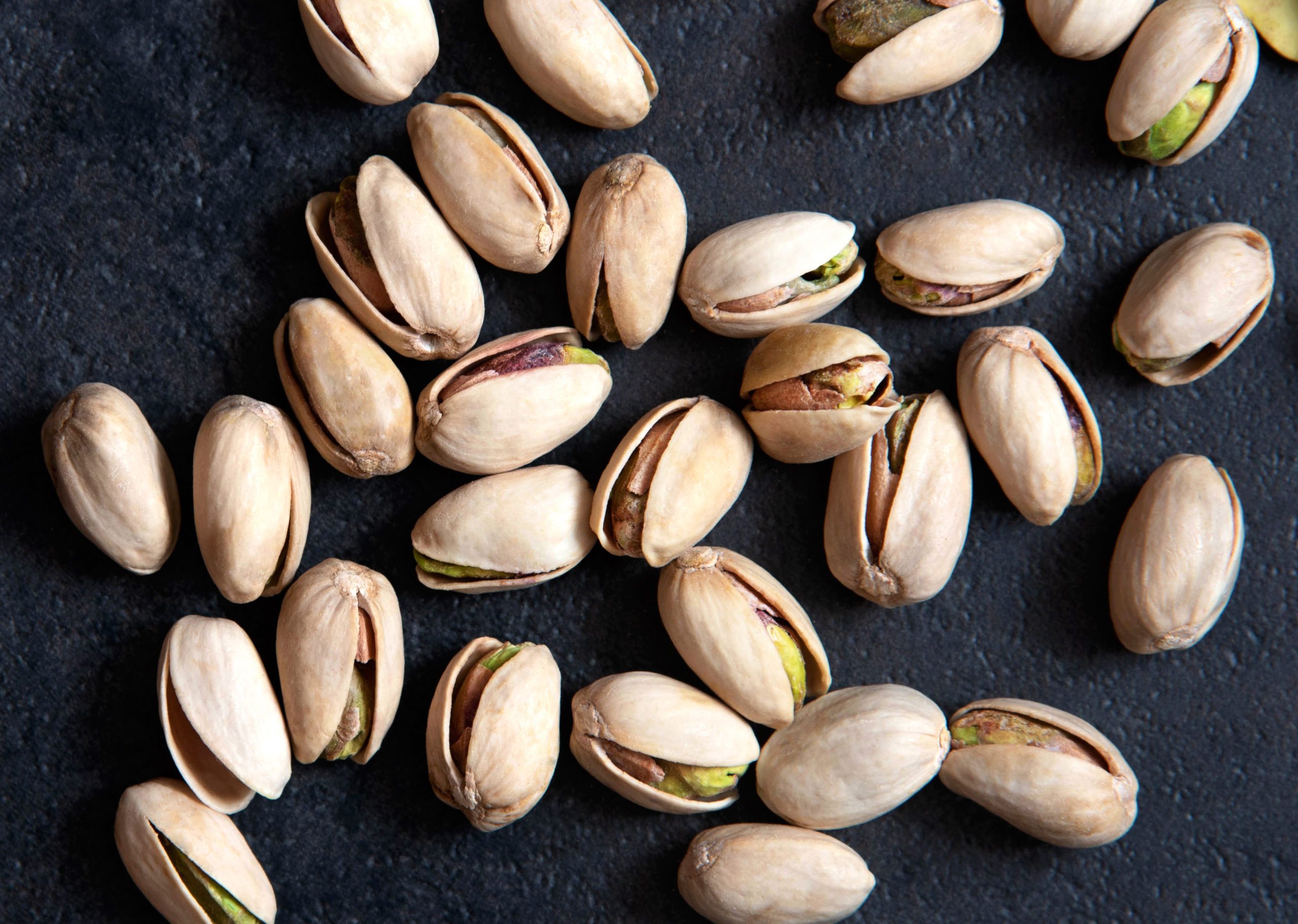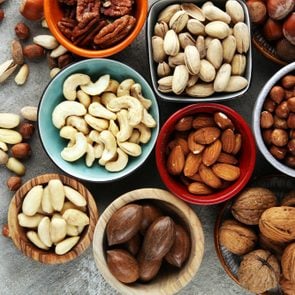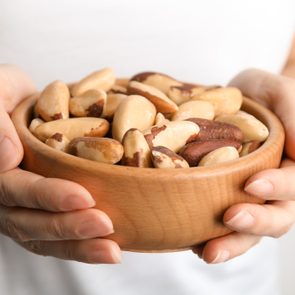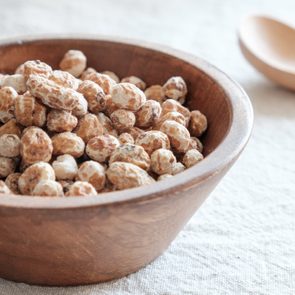Are Pistachios Good for You? Their Nutrition, Calories, and Health Benefits
Updated: Mar. 30, 2022
Pistachios are green tasty tree nuts packed with nutrition, especially protein. Here's what you need to know about calories, benefits, and more.
The pistachio: A little green gem packed with protein
One great thing the pistachio has going for it is an easy-access feature. This tasty treat is split on one side—just enough space to wedge in your fingernail to separate and break open the shell.
Like most culinary nuts (more on this later), pistachios are packed with nutritious benefits, but they’re attracting more attention for one nutrient in particular—protein. Each one-ounce serving contains six grams of protein.
“That’s as much as an egg,” says Cat Martin, RD, UCHealth University of Colorado Hospital. “This makes pistachios a great source of plant-based protein, particularly for those following vegan or vegetarian diets.” And we’re not talking just any run-of-the-mill protein.
Learn why this type of protein has nutritional value, plus calories, health benefits, and the ways to eat pistachios. (Pistachios are among the healthiest nuts you can eat.)
Are pistachio actually nuts?
First, let’s clear things up. Pistachios aren’t actually nuts—at least not botanically. Botanical nuts refer to fruits that contain a hard shell and a seed that is generally edible. Botanical nuts don’t have shells that open and release their seeds. Examples of botanical nuts include hazelnuts and acorns.
Pistachios originate from the seed of the pistachio tree fruit (Pistacia vera tree) and they’re part of the cashew family. (Learn more about how cashews grow.)
So, although they’re actually a seed, in the culinary world, pistachios are grouped together with hazelnuts, almonds, and cashews as nuts. They’re also considered a tree nut allergen.
Where and how they grow
Pistachios have only been growing on American soil since the 1960s. Before then, they were always imported. In 1929, an American botanist took a trip to Persia (now known as Iran) to collect pistachios. It took some time to perfect the growing process, but now pistachios thrive in the dry climates of California, Arizona, and New Mexico.
The pistachio tree is unique in that it has wide-spreading branches, with the pistachios grow in clusters, much like grapes. It takes about 10 to 12 years before the tree starts producing a sizeable crop. Even more fascinating is that there are male and female trees, and only the female produces pistachios.
The male tree does its part too. It contributes a vital component—the pollen by way of the wind, not bee pollination. (Pistachios are one of many brain-boosting foods that can make you smarter.)
Pistachio nutrition facts
The pistachio is packed with nutrients, including protein, fiber, healthy fats, and antioxidants. Here are the nutrition facts for one ounce (49 kernels) of raw pistachios:
Calories: 159
Carbs: 8 g (3 percent Daily Value)
Fiber: 3 g (12 percent DV)
Protein: 6 g (12 percent DV)
Total Fat: 13 g (19 percent DV)
Sodium: 0 mg
Sugar: 2 g
Potassium: 291 mg (8 percent DV)
Lower in calories than other nuts
Pistachios are lower in calories per serving than other nuts such as Brazil nuts, pecans, and macadamia nuts. If that’s important to you, it means you can eat around 49 pistachios (159 calories) versus 19 pecans (196 calories) or 12 macadamia nuts (204 calories). If you are watching your portion control and trying to eat only a few servings, consider buying pistachios with the shell on.
“An interesting study from 2011 investigated the effect of eating in-shell pistachios compared to deshelled pistachios on satiety and total calories consumed. The group eating in-shell pistachios consumed 41 percent fewer calories compared to the group eating de-shelled pistachios,” Martin says.
The study authors speculate this might be due to the time it took to de-shell the nut or the total perceived amount of nuts that made participants feel like they were eating more.
“This study confirms for me that pistachios have a great ‘snacking’ factor—in that they are a little more fun to eat! And needing to de-shell the nuts may promote mindful eating and encourage consumers to eat a little slower,” says Martin.

Are pistachios good for you?
When it comes to this edible seed, there’s plenty of health benefits thanks to its nutrition profile.
Good source of heart-healthy fats
“The fatty acid profile of pistachios consists of over 50 percent monounsaturated fatty acids—the same healthy fats in olive oil and avocados,” says Martin.
“The monounsaturated fats found in pistachios have been demonstrated to reduce total cholesterol, LDL (“bad”) cholesterol, and triglycerides, and increase HDL (“good”) cholesterol,” says Martin. “Such lipid profile changes are associated with a lower risk for cardiovascular disease,” adds Martin.
Pistachios do have a bit of unhealthy saturated fats, but at under two grams per serving, it’s a modest amount, according to Martin. The American Heart Association recommends eating no more than 13 grams of saturated fat per day.
Rich source for vitamin B6
Pistachios outshine other nuts—and other foods as well. “They are one of the most vitamin B6-rich food outs there,” says Emily Holdorf, RD, Colgate University in Hamilton, New York. Why is that a good thing?
“Vitamin B6 is important for forming hemoglobin in the body, which helps carry oxygen in red blood cells,” says Holdorf. In addition, B6 also helps keep the nervous system and immune system healthy, and it helps with normal brain development.
High in trace minerals
The “trace” in trace minerals doesn’t mean they’re insignificant. The human body needs minerals and trace minerals to perform properly. Pistachios are rich in the trace minerals potassium, phosphorus, and copper.
A serving size of pistachios has more potassium than half of a banana, Holdorf says. (This might convince you to eat a banana every day.) Potassium regulates fluid levels in the body, nerve function, and muscle movement. Phosphorus is needed to make energy and is in every cell in our body, mainly in our bones and teeth.
Pistachios also contain a substantial amount of copper. “By eating foods high in copper, it helps to prevent cardiovascular disease and osteoporosis. Copper also helps boost immune function and collagen production,” says Holdorf. Collagen supports bone, hair, and skin functions.
Support healthy eyes
Pistachios are rich in the antioxidants, lutein and zeaxanthin with 2,903 micrograms per serving. That’s more than other nuts and puts them in good company with stellar lutein and zeaxanthin-rich foods such as spinach, squash, and broccoli.
Lutein and zeaxanthin protect cells from harmful free radicals in your eyes. They may also protect against age-related macular degeneration and cataract development.
A 2017 study published in Nutrients suggests that diets higher in lutein and zeaxanthin play an important role in protecting against age-related macular degeneration. Another study published in the American Journal of Public Health linked eating higher amounts of lutein and zeaxanthin with a lower risk of developing cataracts. These nutrients improved vision in older people who had cataracts but weren’t eating much lutein and zeaxanthin-rich foods before the study.
As promising as these studies are, you shouldn’t start eating pistachios by the handfuls. More research is needed to determine how much lutein and zeaxanthin should be consumed and how long it takes to show benefits. A healthy diet, exercise, not smoking, and wearing protective eyewear to minimize sun damage are just a few things you can do to help preserve your eyesight.
Powerful protein source
Remember the protein we mentioned earlier? The protein found in pistachio nuts is classified as a complete protein, meaning it includes essential amino acids. That’s especially good news for people who eat plant-based diets because most plant-based foods only contain incomplete proteins.
“Essential amino acids are essential because your body can’t make them. They have to come from food,” says Holdorf.
“They are the simplest form of protein. Essentially, they combine to form incomplete and complete proteins. When proteins are broken down, amino acids are left. Pistachios provide adequate amounts of all 9 essential amino acids, making them a complete protein,” says Holdorf.
Some other foods with complete proteins included quinoa, chickpeas, and soybeans.
How to choose pistachios
To cash in on their healthy goodness, choose raw or roasted pistachios in the shell or shelled. Be aware: Shelled pistachios are more expensive. Pistachios that are roasted and salted have added sodium.
If you crave salty flavor, look for lightly salted. Remember, flavored pistachios contain added sugars, oils, and preservatives, Holdorf warns. Like other nuts, pistachios will keep longer if you don’t store them in the pantry.
In-shell or shelled pistachios stay fresh in the fridge for about a year or in the freezer for up to three years. Most pistachios will already have the trademark split in the shell—indicating they are mature and ripe. If they’re not split, they’re still edible but not as tasty. The hull (a thin layer covering the nut inside the shell) starts to turn reddish, signifying the pistachio is ripe and delicious.
How much and how often should you eat pistachios?
Unless you have a tree nut allergy, Holdorf suggests following the American Heart Association guidelines and eat about four servings of unsalted nuts a week. That doesn’t mean you should eat only pistachios. Martin says you can reap the benefits of pistachios even if you only eat them a few times a week.
“Considering that different types of nuts provide slightly different amounts of vitamins and minerals, I would recommend switching up what types of nuts you are eating regularly,” Martin says.
Tasty ways to eat pistachios
It turns out pistachios are pretty versatile and add a delicious flavor profile to lots of food you’re already eating. Holdorf suggests using pistachios in homemade pesto instead of pine nuts or as crunchy topping in soups. She also uses crushed pistachios in energy bites, granola bars, or homemade granola.
Martin adds pistachios to a homemade trail mix to fuel her hikes. She also likes pistachios as toppings for salads and yogurt parfaits. For a nutrient-rich meal, try pistachio-crusted salmon to take in the healthy fat combo of monounsaturated and polyunsaturated fats.





















